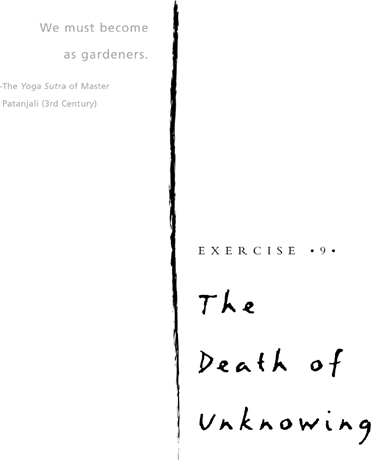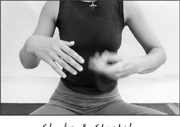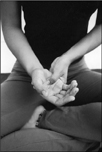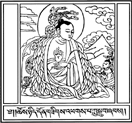

Verses about yoga written more than six hundred years ago advise us to lie down quietly after a yoga session, to “calm the body and refresh the mind.” The classic resting position is known as the Dead Man's Pose (Shava Asana), because physically the goal is to lie as still as a corpse.
Mentally we are still giving, still working from the inside. At the end of the exercise we do a brief pose from the tradition of the Dalai Lamas known as Shake & Stretch (Trukdreng), followed by a quiet moment of taking pleasure in the goodness of what we've tried to do with our yoga session.
Time: 4 minutes.
Begin the Dead Man's Pose: Lie down on your mat and let your arms and legs fall comfortably out to the sides. Keep the palms of your hands facing up, and the fingers relaxed. Lengthen your neck and pull your head away from the rest of the body, then let it relax, closing your eyes. You can cover yourself with a blanket if you like.

Dead Man's Pose
Breathe slowly out and in, and feel the weight of your body sink into the floor. Find any tension that you have in your body and let it go—picture it dissolving into the floor. Concentrate on this for about two minutes.
Then, lying relaxed and quiet, take a breath in and say, “I send you wisdom.”
Remain still like this for two more minutes, sending the breath and light.
Next do the Shake & Stretch. Slowly start to move your hands and feet, stretching them and shaking them out. Turn your head from side to side on the floor.
Take hold of each of the fingers of the right hand with the left, and one by one pull gently at the joints. Then switch and do the fingers of the other hand.

Shake & Stretch, shaking out hands
Knead each palm and finger with the thumb of the opposite hand.

Shake & Stretch, pulling joints
Wring out your hands as if you were washing them.
Now slowly turn onto your side, and push yourself up with your hands to a seated position.
Sit quietly for a moment. Remember the six gifts you have given, from the diamond and the rose at your heart. Be happy that you have tried to make someone else happy.

Shake & Stretch, kneading hands
Gaze one last time at the bridge of soft-blue light between your diamond and theirs. For a moment, just a moment, imagine that there are countless bridges of light like this between your heart and the hearts of every single living being, on every single planet in the entire universe.
In this final exercise on the mat, we strive simply to relax every single part of our body. It's a well-earned rest, but you may discover that you begin to tense up at the usual places, just by habit. Put it on your mental checklist to stay vigilant, looking for spots that still need to relax.
There should be a change here at the second level, in your breathing. Relax the part of the throat that helped you make the sighing noise up to now, but still let the air sweep over the same spot in your throat, both on the out-breath and the in-breath. This helps the inner winds flow better in all three major channels, at the back of the neck. Try now to make long and very silent breaths.
Take some time to think about all five levels; you can even picture yourself dropping down through each of them, deep into your body. Be aware of the physical body relaxing and the quieting of the breath. Follow the quiet breath down to the inner winds; see if you can actually feel them. Don't look for something that feels like the air from a fan going through a soda straw. The inner winds as they sing now through the inner channels are much more likely to feel like the simple contentment you experience as you sit quietly on the side of a forest mountain, or at the edge of the sea at night.
Come down now to your thoughts, riding on these gentle new winds. Think about the final gift: the gift of wisdom, the gift of knowing important things, the deeper things of life.

Of course, wisdom comes in as many flavors as ice cream does. What we're talking about here is a very specific kind of wisdom.

Naga Arjuna (3rd Century), Master of Wisdom
Wherever the Dalai Lama goes, whatever he says, he repeats one thing over and over. Despite all the differences between the people on this Earth, we are all the same in one way. We all want things to go well for us, and nobody wants any of the problems or trouble of life. But problems and trouble do come to us; we are never free of them for very long. Wisdom is understanding where these problems really come from, and how to stop them.
All through our session of Tibetan Heart Yoga so far, we've been trying to plant new good seeds in our minds, by thinking kind thoughts, even as we work on our body. If you do your yoga this way—patiently, happily, day after day—then your mental supply of good seeds grows and grows.
Remember that, according to the greatest wisdom of the masters of ancient India and Tibet, these seeds ripen in our minds and color how we see both everything around us and everything about us. If we have been kind and considerate toward others, then these seeds come back to us later. They color how we see our very world; for example, you may find the weather, whatever it is, more and more enjoyable. They color how we see other people: You'll discover that fewer and fewer people annoy you through the day. They color even how we see ourselves: Your yoga begins to work on you—you feel stronger, younger, and simply a lot happier than ever before.